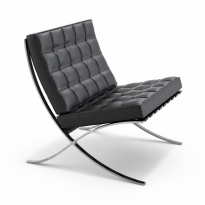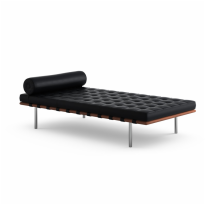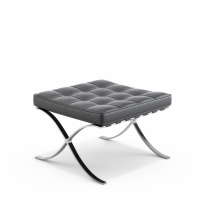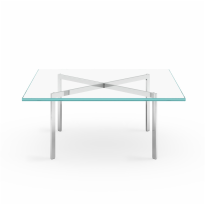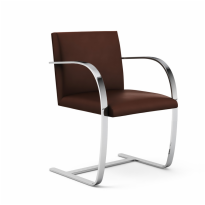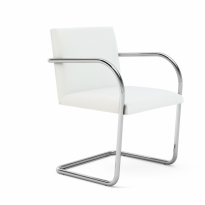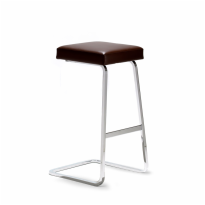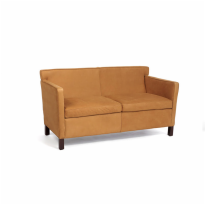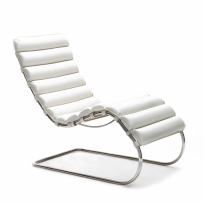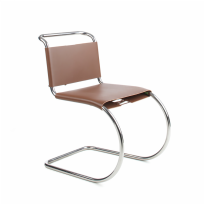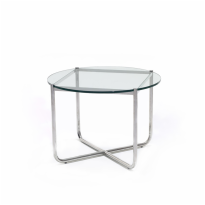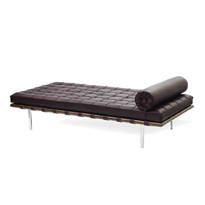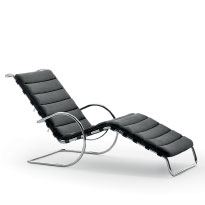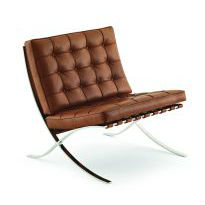Sarah Rogers Morris
Associate Director of the Mies Society on preserving the architect's legacy
Sarah Rogers Morris is Associate Director of the Mies van der Rohe Society, an organization whose mission is to preserve the architect Ludwig Mies van der Rohe’s legacy and maintain the integrity of his buildings.
Before joining the Mies van der Rohe Society, Morris worked as a freelance writer covering design and architecture. Her work as been featured in publications ranging from Pin-Up to Architect's Newspaper. She has also held posts at MoMA, The Judd Foundation and The Frank Lloyd Wright Preservation Society, and holds an MA in the history of design, decorative arts, and material culture from the Bard Graduate Center.
Morris sat down with Knoll Inspiration to discuss the institution's upcoming celebration of Ludwig Mies van der Rohe's 130th birthday, titled "Modern Material," which takes place on March 31, 2016 at Crown Hall from 6:00pm to 9:00pm. For ticket information, visit IIT.
 Ludwig Mies van der Rohe's Crown Hall at Illinois Institute of Technology, 1950-1956. Image courtesy of the Mies Society.
Ludwig Mies van der Rohe's Crown Hall at Illinois Institute of Technology, 1950-1956. Image courtesy of the Mies Society.
KNOLL INSPIRATION: What initiatives are on the horizon for 2016?
Sarah Rogers Morris: Our major projects this year will be launching a new, multimedia audio tour of campus that features archival photography, video and audio; reviving our guided tours, which are led by students from the College of Architecture and have been on a hiatus; the redesign of our website; and the expansion of our programmatic activities—performances, lectures, site-specific installations and other events that bring people to and provoke thinking about our Mies-designed spaces. We want to engage the public with Illinois Tech’s Mies campus. The ultimate goal is to promote fresh interpretations of and bring greater exposure to his work on campus, in Chicago and beyond.
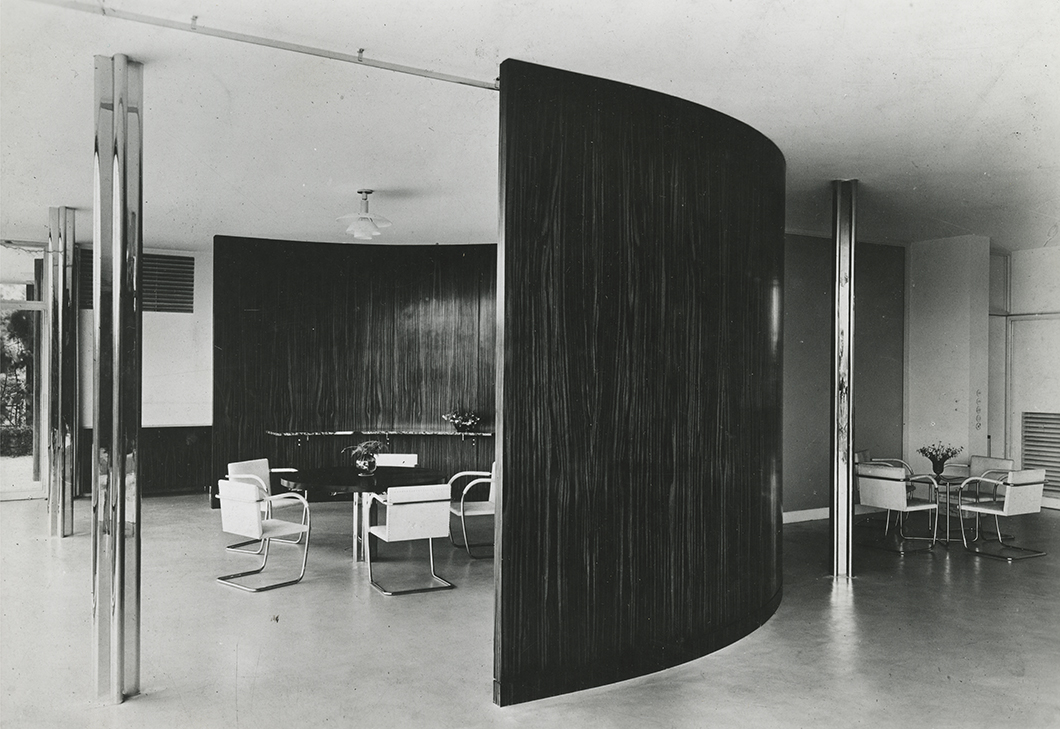 Ludwig Mies van der Rohe's Villa Tugendhat, 1930. Image from the Knoll Archive.
Ludwig Mies van der Rohe's Villa Tugendhat, 1930. Image from the Knoll Archive.
Mies’ architecture is "as close as we get to antiquity in the United States.” Those are the words of Michael Jefferson, the Senior Vice President of Wright auction house. Would you characterize the Society’s preservation goals in similar terms, that of safeguarding America’s architectural antiquity?
Mies’ buildings certainly belong to the canon of architectural history. In that sense, yes, the Mies Society plays an important part in safeguarding America’s architectural antiquity. Beyond preserving the physical environment, I think that our role in preservation is about telling the diverse stories surrounding Mies’ architecture—those of the community; the students, faculty and staff who inhabit Mies’ buildings; the reception of and critical responses to his work; and the unique cultural, social and economic circumstances that led to the design, construction and continued use of his buildings, for instance.
 MR Collection by Ludwig Mies van der Rohe, 1927. Image from the Knoll Archive.
MR Collection by Ludwig Mies van der Rohe, 1927. Image from the Knoll Archive.
Mies conceived of his furniture designs as part and parcel of his architectural works and rarely allowed external furniture to be brought into his completed projects. To this point, he famously said: “A chair is a very difficult object. A skyscraper is almost easier.” While the Mies Society is dedicated to preserving Mies’ architectural works, how do examples of Mies’ furniture—Brno Chair, MR Chair, Barcelona Chair, etc.—fit within that objective?
Mies’ design for Illinois Tech’s campus was developed with an emphasis on flexibility. Mies understood that that the needs of the university would change over time. In developing the campus master plan, he devised a 24-foot grid that promoted modularity and anticipated that additional buildings by other architects would someday be added—these additions to campus could simply be plugged into the grid. Likewise, Mies innovated the concept of universal space in projects like Crown Hall. The open, uninterrupted floor plan there—a result of the building’s structural program—could be reconfigured with furniture and unfixed partitions to accommodate different types of activity over time. In this sense, I think Mies had a lot of compassion for the needs of the end-users. You might not find the same degree of spatial flexibility in some of his residential projects. That said, we have some great examples of Mies’ furniture designs around campus, and they certainly reinforce the Miesian aesthetic.
 Portrait of Ludwig Mies van der Rohe. Image from the Knoll Archive.
Portrait of Ludwig Mies van der Rohe. Image from the Knoll Archive.
The Mies Society is celebrating Ludwig Mies van der Rohe’s 130th birthday on March 27, 2016. How is the celebration going to differ from others you've hosted in the past?
The Mies Society hosts a birthday party every March to celebrate Mies’ legacy. This year is special because we’re partnering with The Second City, an improvisational theater company that has its own very important history here in Chicago and in the comedy world. Comedy greats like Bill Murray, Steve Carell, Amy Sedaris and Tina Fey came out of The Second City, and the theater continues to produce first-rate productions and talent. Our event is titled “Modern Material,” and it will look at Mies’ work through a comedic lens. By doing so, we hope the performance will provoke a playful and energetic conversation around the subject and bring new audiences to campus—the event will take place in Crown Hall.
 The Titanic by Stanley Tigerman, 1978. Image courtesy of Stanley Tigerman and The Art Institute of Chicago.
The Titanic by Stanley Tigerman, 1978. Image courtesy of Stanley Tigerman and The Art Institute of Chicago.
I'm glad you brought up Second City's collaboration with the Mies Society. What is the connection between comedy and architecture? Or, rather, what can comedy tell us about architecture?
I think that comedy can be seen as a form of critique. Stanley Tigerman’s famous The Titanic collage, which shows Crown Hall capsized in Lake Michigan, is a perfect example of that. Puffy, happy-looking clouds dot the sky as Mies’ masterpiece, an icon of twentieth century design, sinks into oblivion. The collage wasn’t meant to diminish Mies or his architecture, but rather to propose alternatives to high modernism in architecture. This kind of innocent irreverence challenges us to think or see something in a way that we aren’t used to. I think that’s the value in approaching architecture with levity and a sense of humor.
 Illinois Institute of Technology by Ludwig Mies van der Rohe, 1938-1958. Image from the Knoll Archive.
Illinois Institute of Technology by Ludwig Mies van der Rohe, 1938-1958. Image from the Knoll Archive.
There’s a great connection between Mies, the Illinois Institute of Technology and the city of Chicago. Mies taught and built some of the most important architectural projects of the 20th century while at IIT. Can you speak to this triangle of reciprocal influence?
At the time of his arrival in Chicago, the city was on the brink of a major urban renewal effort. Mies had already established himself as an important architect, and the city was very receptive to his ideas. He wound up transforming the Chicago skyline not just with his own work but by influencing generations of architects as head of the College of Architecture at Illinois Tech. Lake Point Tower and McCormick Place are just a few examples of buildings designed by Mies’ students. His architecture also had a tremendous impact on the designs coming out of the offices of SOM and C.F. Murphy—the Inland Steel Building, the Hancock building, and the Sears tower, for example.
 Farnsworth House by Ludwig Mies van der Rohe, 1930. Photograph by Scott Frances.
Farnsworth House by Ludwig Mies van der Rohe, 1930. Photograph by Scott Frances.
Finally, Mies famously argued that modern architecture should aim to transcend both rational and economic fulfillment to create “architecture as art.” In your experience, how does the visiting public approach Mies’ work, as architecture or as art?
Robert Venturi talked about how Mies elevated ordinary industrial materials and methods of construction as art. You see this immediately in projects like the Farnsworth House and Crown Hall, which are very elegant in their construction. Other of Mies’ buildings can be more challenging if you’re not an architect or trained to recognize how those structures depart dramatically from anything that came before. The Minerals and Metals building on campus is an example of that. I’ve heard people say, “But it’s just a factory building.” Part of the Mies Society’s job is to help the visiting public look at and appreciate Mies’ contributions—his sense of economy, scale and proportion; the precision with which he handled brick, steel and glass; and his bold willingness to break with tradition in order to create something entirely new. The audio and guided tours that we’ll be launching in the next year will be a vehicle for advancing this educational objective.
Mies Van Der Rohe - Architecture as language from Alexandre Favre on Vimeo.
All images are courtesy from the Knoll Archive unless otherwise noted.
"The Mies Society’s job is to help the visiting public look at and appreciate Mies’ contribution—his bold willingness to break with tradition in order to create something entirely new."
